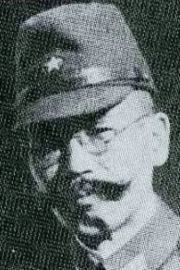![]() The Pacific War Online Encyclopedia
The Pacific War Online Encyclopedia
|
| Previous: Kavieng | Table of Contents | Next: Kawabe Torashiro |

Kawabe Masakazu (Kawabe Masakasu) was born in Toyama prefecture and graduated from the Japanese military academy in 1907 and the Army Staff College in 1917. Following the First World War, he traveled extensively abroad, and served in the embassies in Switzerland (1918-1921) and Germany (late 1920s). In the xenophobic atmosphere of the Japanese Army, such extensive experience abroad was unusual and was even regarded as suspect — a source of contaminating Western ideas.
During the 1930s Kawabe served in a number of
posts in China, including command of
Permanent China Brigade, which
was involved in the Marco Polo Bridge Incident. By late 1941 he
was a lieutenant general in
command of 3 Army in eastern Manchuria. In
the eyes of the Japanese Army, which always regarded Russia
as the great enemy, this was an extremely important post. He
subsequently became chief of staff of China
Expeditionary Army, in August 1942.
On 8 April 1943 Kawabe was reassigned to command
the Burma
Area Army. His leadership would be characterized by an
enormous
disregard for human life, even that of his own troops. The
disastrous U-Go offensive
against Imphal
took place under his command in March of 1944. During the later
stages of this offensive, he was bedridden with amoebic dysentery and
under pressure from his own superior at Southern Army.
In September 1944 he was
recalled to Japan, promoted to full general, and given command of Central
District Army and 15 Area Army.
On 8 April 1945 he took command of General Air Army, consisting of the remaining air units in Japan, Korea, and the Ryukyus, for the final defense
against the anticipated Allied
invasion. He replaced Dohihara
as commander of 1 General Army
for demobilization after the latter was arrested for war crimes. Kawabe himself was
arrested for his involvement in the Marco Polo Bridge Incident, but was
released without standing trial, probably because he was absent when
the incident took place.
Boatner describes Kawabe as "An anxious, austere,
emaciated little man (small even by Japanese standards) who looked sick
most of the time." Slim considered his tactics inflexible and predictable, particularly in comparison with his successor at Burma Area Army, Kimura Heitaro. Kawabe did not get along nearly so well with Ba Maw, the puppet Burmese Prime Minister, as his predecessor, Iida.
| 1886
|
Born in Toyama prefecture |
|
| 1907 |
Second
lieutenant |
Graduates from Military Academy |
| 1915 |
Army Staff College |
|
| 1918 |
Resident officer, Switzerland |
|
| 1925 |
General Staff |
|
| 1927 |
Colonel |
Instructor, War College |
| 1929 |
Military attache, Germany |
|
| 1932 |
Commander, 6 Regiment |
|
| 1933 |
Commander, Training Regiment,
Toyama Army Infantry School |
|
| 1934 |
Chief, 1 Section,
Inspectorate-General of Military Training |
|
| 1936-4 |
Major general | Commander, Permanent China
Brigade |
| 1937-8-26 |
Deputy chief of staff, North
China Area Army |
|
| 1938-2-14
|
Chief of staff, Central China
Expeditionary Army |
|
| 1939-1-31 |
Lieutenant general | Deputy Inspector-General of
Military Training |
| 1939-9-12 |
Inspector-General of Military
Training |
|
| 1940-10-14 |
Commander, 12 Division |
|
| 1941-3-1 |
Commander, 3 Army | |
| 1942-8-17 |
Chief of staff, China Expeditionary Army | |
| 1943-3-18 |
Commander, Burma Area Army |
|
| 1944-8-30 |
` |
Supreme War Council |
| 1944-12 |
Commander, Central
District Army |
|
| 1945-2-1 |
Commander, 15 Area Army |
|
| 1945-4-7 |
General | Commander, General Air Army |
| 1945-9-12 |
Head, Army Aeronautical
Department, Ministry of War |
|
| 1945-10-1 |
Commander, 1 General Army |
|
| 1945 |
Retires |
|
| 1945 |
Arrested on suspicion of war crimes | |
| 1947 |
Released |
|
| 1965 |
Dies |
References
Generals.dk
(accessed 2008-4-17)
The Pacific War Online Encyclopedia © 2007, 2010-2011 by Kent G. Budge. Index